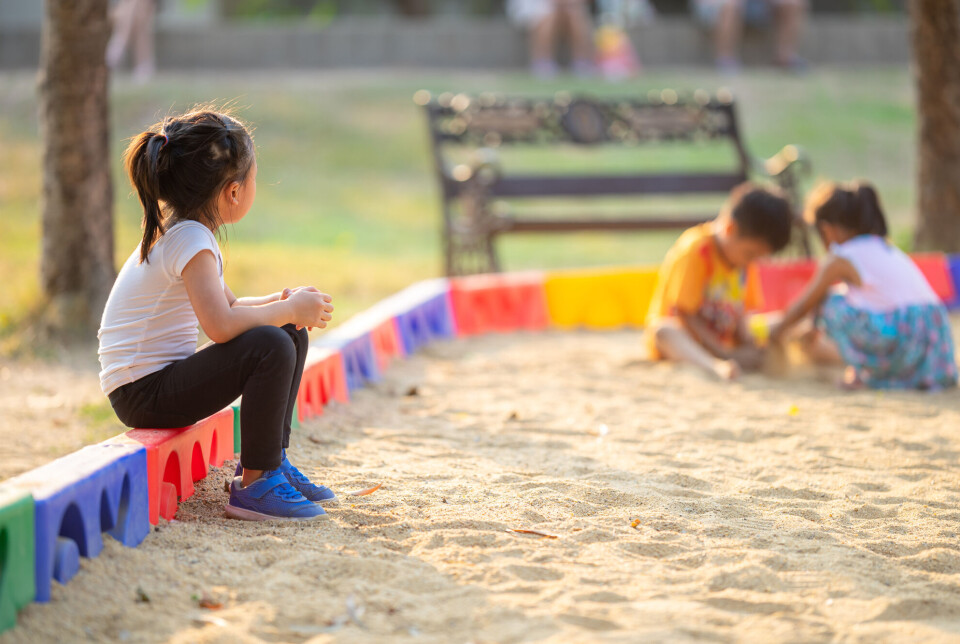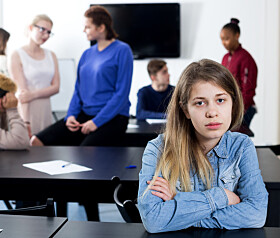
Shy children are more likely to be sad and more anxious than other children
Children who find it particularly difficult to get close to others are often sad, says the researcher behind a new Norwegian study.
“People don't think that children walk around feeling sad, but we see that things can be very difficult for shy children who aren't able to make social contact with others,” says Mona Bekkhus.
Bekkhus is an associate professor in developmental psychology at the University of Oslo and the main researcher behind a new study which shows that there is a connection between shyness and emotional difficulties in children.
What is shyness?
According to the researchers behind the study, shyness can be characterized by several different aspects. A shy person can, for example, feel tension, worry and discomfort in social contexts — and have expectations of negative reactions from others.
Those who are shy may avoid social situations and be reserved in the presence of others. These characteristics can lead to challenges in social relationships.
Bekkhus explains that shy children may find it difficult to reach out to other children to ask about playing with them.
Want contact
The study was carried out by the research centre PROMENTA at the University of Oslo.
The researchers have uncovered a connection between shyness and emotional difficulties, such as anxiety and sadness.
They have found that there are two aspects of shyness in particular that can be linked to emotional difficulties. One is to observe others without making contact. The second is to reject others. The researchers believe this indicates that much of the direct relationship between shyness and emotional difficulties is due to problems interacting with others.
Bekkhus points out that many shy children want social contact, but that they find it difficult to reach out.
“We saw that the children who find it particularly difficult to approach others are often sad, down or on the verge of tears,” she said.
“I think that’s important to know if you work with children,” Bekkhus said.
Easy to overlook
Kirsten Flaten is a lecturer in special pedagogy at the Western Norway University of Applied Sciences and has written a book about how teachers can support shy students. She explains that anxiety and unhappiness are a natural part of shyness, because you feel you have a potential that you are not realizing.
“All children want to live a life that is rich in social experiences and relationships. But these children don't manage this, and feel left out. It’s no wonder that they’re sad,” she said.
She thinks that the PROMENTA study doesn’t necessarily say anything new, but that it does confirm what researchers already knew.
“And that’s important, because the shy children are a group that we easily overlook,” she said.

The quiet children
Bekkhus says that we haven’t always paid attention to children who are quiet.
“There has traditionally been a big focus on children who act out in the classroom, those who are physical and answer back to teachers. So perhaps not as much attention has been paid to the quiet children,” she says.
But she believes that people who work with children and schools themselves have become more aware of this issue now.
Difficult transition
The study's findings show that shy children become more anxious in the transition from nursery school to primary school.
Bekkhus says it’s a bit difficult to explain exactly why that’s the case.
“But I think one way to explain it is that there can be slightly different types of expectations for the children when they go to school,” she said.
She says that there is often closer contact with adults in kindergarten as compared to primary school. Groups are also larger in primary school.
“There is also a certain expectation that when children are older, they will take more initiative and engage more with their peers,” Bekkhus said.
She says that this can be difficult for shy children.
Flaten believes that the increased problems in the transition from nursery school to school may be due to the increasing expectation that children will also learn new skills.
“You have to understand letters, you have understand numbers. It’s much more of an assessment culture,” she said.
She says that there is also a greater focus on the individual in primary school. For example, children have to cope individually to a greater extent when it comes to social activities during recess. In addition, there are often classroom situations where each student must read aloud.
“Most shy children will struggle to respond in class,” she says.
It’s possible to help
What can be done to help shy children?
Flaten says that shy children often try to avoid the teacher's attention. She emphasizes that it's important that teachers not be put off by this, but rather seek to acknowledge and give attention in discreet ways.
Another positive approach can be to organize the children’s free time by giving them an offer of activities they can do, she said.
“Then they have something to do and don't have to come up with something themselves, and they don't have to be alone,” she said.
Flaten also explains that it’s possible for parents to help shy children, but that they should start early.
“It's about not letting them avoid everything they find uncomfortable,” she said.
“If you are at the store and they say they want something, you can say ‘Yes, you can have it, but then you have to go and buy it yourself.’ That assertiveness can be difficult, but is also very important,” she said.
Flaten adds that it can be useful to get shy children into playgroups and see that the child is both visited by and visits playmates. It is also useful for these children to participate in organized free time activities, preferably with the parents as support.

Adult contact important
Bekkhus believes it is possible to help shy children to better cope with their shyness. It can be useful to talk to them about how they think and what they feel, she said.
“It’s possible to help them build better social skills by teaching them techniques that can make it easier to cope with social situations,” she said.
Like Flaten, she believes that it can be positive for shy children to have more contact with adults in primary school, such as during recess.
Not just negative
Are there any positive aspects to being shy?
“If you are so shy that you are paralyzed by it, I see little positive in that,” Flaten said.
But she believes a little bit of shyness can make people a little more charming, because they are not brash or aggressive.
“You feel as if you are seen with them. They are also seen as loyal, good friends. Children who are shy know how difficult it is to make friends, so they are very nice to the friends they have,” she said.
Flaten points out that it is important to recognize the positive aspects of shyness.
“It is very much a part of one’s personality, this thing about being shy. And we can't make people into people that they aren’t, but we can show them the good aspects of being the way they are,” she said.
Translated by Nancy Bazilchuk
Reference:
Mona Bekkhus et.al.: Developmental changes in the structure of shyness and internalizing symptoms from early to middle childhood: A network analysis. Child Development, 2023. Summary.
Read the Norwegian version of this article at forskning.no
———





































